Evolution of Vegetation Growth Season on the Loess Plateau under Future Climate Scenarios
Abstract
:1. Introduction
2. Materials and Methods
2.1. Study Area
2.2. Data Source and Processing
2.3. Statistical Analysis
3. Results
3.1. Characteristics of Spatio-Temporal Variation in Growing Season
3.2. Temperature and Precipitation Trends in the Loess Plateau from 1982 to 2015
3.3. Response of SOS to Changes in Temperatureand Precipitation in Spring
3.4. Response of EOS to the Changes in Temperature and Precipitation in Summer and Autumn
3.5. Prediction of Climate Change under Different Climate Scenarios
3.6. Prediction of Phenological Changes under Different Climatic Scenarios
4. Discussion
5. Conclusions
Author Contributions
Funding
Data Availability Statement
Conflicts of Interest
References
- Badeck, F.W.; Bondeau, A.K.; Doktor, D.; Lucht, W.; Schaber, J. Responses of spring phenology to climate change. New Phytol. 2004, 162, 295–309. [Google Scholar] [CrossRef]
- Richardson, A.D.; Keenan, T.F.; Migliavacca, M.; Ryu, Y.; Sonnentag, O.; Toomey, M. Climate change, phenology, and phenological control of vegetation feedbacks to the climate system. Agric. For. Meteorol. 2013, 169, 156–173. [Google Scholar] [CrossRef]
- Kong, D.; Zhang, Q. Changes in vegetation phenology and meteorological factors on the Qinghai Tibet Plateau from 1982 to 2013. J. Geogr. Sci. 2017, 72, 39–52. (In Chinese) [Google Scholar]
- Zhen, J.; Ge, Q. Changes of Plant Phenological Period and Its Response to Climate Change for the last 40 years in China. Agric. Meteorol. 2003, 24, 28–32. (In Chinese) [Google Scholar]
- Zheng, J.; Ge, Q.; Hao, Z. Impacts of climate warming on plants phenophases in China for the last 40 years. Chin. Sci. Bull. 2002, 47, 1826–1831. [Google Scholar]
- Jeong, S.J.; Chang-Hoi, H.O.; Gim, H.J.; Brown, M.E. Phenology shifts at start vs. end of growing season in temperate vegetation over the Northern Hemisphere for the period 1982–2008. Glob. Chang. Biol. 2011, 17, 2385–2399. [Google Scholar]
- Williams, S.E.; Bolitho, E.E.; Fox, S. Climate change in Australian tropical rainforests: An impending environmental catastrophe. Proc. Biol. Sci. 2003, 270, 1887–1892. [Google Scholar] [CrossRef]
- Ge, Q.; Dai, J.; Zhen, J. Progress in Phenology Research and Challenges Faced by Modern Phenology in China. Bull. Chin. Acad. Sci. 2010, 25, 310–316. (In Chinese) [Google Scholar]
- Zhen, J.; Ge, Q. The impact of climate warming on plant phenological changes in China over the past 40 years. Chin. Sci. Bull. 2002, 47, 64–69. (In Chinese) [Google Scholar]
- Chmielewski, F.M.; Rötzer, T. Response of tree phenology to climate change across Europe. Agric. For. Meteorol. 2001, 108, 101–112. [Google Scholar] [CrossRef]
- Piao, S.L.; Liu, Q.; Chen, A.P.; Janssens, I.A.; Fu, Y.S.; Dai, J.H.; Liu, L.L.; Lian, X.; Shen, M.G.; Zhu, X.L. Plant phenology and global climate change: Current progresses and challenges. Glob. Chang. Biol. 2019, 25, 1922–1940. [Google Scholar] [CrossRef] [PubMed]
- Pörtner, H.-O.; Roberts, D.C.; Tignor, M.; Poloczanska, E.S.; Mintenbeck, K.; Alegría, A.; Craig, M.; Langsdorf, S.; Löschke, S.; Möller, V.; et al. Climate Change 2022: Impacts, Adaptation and Vulnerability. Contribution of Working Group II to the Sixth Assessment Report of the Intergovernmental Panel on Climate Change; Cambridge University Press: Cambridge, UK; New York, NY, USA, 2022; p. 3056. [Google Scholar]
- Peñuelas, J.; Filella, I. Responses to a Warming World. Science 2001, 294, 793–795. [Google Scholar] [CrossRef]
- Menzel, A.; Sparks, T.; Estrella, N.; Koch, E.; Aasa, A.; Ahas, R.; Alm-KÜBler, K.; Bissolli, P.; BraslavskÁ, O.G.; Briede, A.; et al. European phenological response to climate change matches the warming pattern. Glob. Chang. Biol. 2006, 12, 1969–1976. [Google Scholar] [CrossRef]
- Hufkens, K.; Keenan, T.F.; Flanagan, L.B.; Scott, R.L.; Bernacchi, C.J.; Joo, E.; Brunsell, N.A.; Verfaillie, J.; Richardson, A.D. Productivity of North American grasslands is increased under future climate scenarios despite rising aridity. Nat. Clim. Chang. 2016, 6, 710–714. [Google Scholar] [CrossRef]
- Piao, S.; Fang, J.; Zhou, L.; Ciais, P.; Zhu, B. Variations in satellite-derived phenology in China’s temperate vegetation. Glob. Chang. Biol. 2006, 12, 672–685. [Google Scholar] [CrossRef]
- Ma, X.; Bai, H.; He, Y.; Qin, J. The Vegetation Remote Sensing Phenology of Qinling Mountains Based on NDVI and It’s Response to Temperature:Taking within the Territory of Shaanxi as an Example. Sci. Geogr. Sin. 2015, 35, 125–130. (In Chinese) [Google Scholar]
- Li, Q.; Zhang, C.; Ren, Z. Analysis of Temporal and Spatial Variation of Vegetation Phenology in the Loess Plateau. Sci. Agric. Sin. 2016, 49, 4352–4365. (In Chinese) [Google Scholar]
- Liang, N.; Emily, E.R.; Bradley, S. Raymond Projected Changes in Climate Extremes over the Northeastern United States. J. Clim. 2015, 28, 3289–3310. [Google Scholar]
- Intergovernmental Panel on Climate Change (IPCC). Climate Change 2013: The Physical Science Basis; Cambridge University Press: Cambridge, UK, 2014; pp. 31–116. [Google Scholar]
- Duveneck, M.J.; Thompson, J.R. Climate change imposes phenological trade-offs on forest net primary productivity. J. Geophys. Res. 2017, 122, 2298–2313. [Google Scholar] [CrossRef]
- Xie, Y.; Wang, X.; Silander, J.A., Jr. Deciduous forest responses to temperature, precipitation, and drought imply complex climate change impacts. Proc. Natl. Acad. Sci. USA 2015, 112, 13585–13590. [Google Scholar] [CrossRef]
- Ling, X. Study on the Spatiotemporal Changes of Vegetation Phenology in the Qinghai Tibet Plateau under Climate Change Scenarios; University of Electronic Science and Technology: Chengdu, China, 2022. (In Chinese) [Google Scholar]
- Wang, X. Simulation and Impact Mechanism of Regional Vegetation Phenological Changes Based on Multi Source Data; University of the Chinese Academy of Sciences: Beijing, China, 2018. (In Chinese) [Google Scholar]
- Gou, J.J.; Wang, F.; Jin, K.; Dong, Q. Cooling ellectindueed by vegetation restoration on the Loess Platea. Acta Feologica Sin. 2017, 38, 3970–3978. (In Chinese) [Google Scholar]
- Xie, B.N.; Qin, Z.F.; Wang, Y.; Chang, Q.R. Spatial and temporal variation in terrestrial net primary productivity on Chinese Loess Plateau and its influential factors. J. Trans. Chin. Soc. Agric. Eng. 2014, 30, 252–261. (In Chinese) [Google Scholar]
- Ji, Z.X.; Pei, T.T.; Chen, Y.; Qin, G.X.; Hou, Q.Q.; Xie, B.P.; Wu, H.W. Vegetation phenology change and its response to seasonal climate changes on the Loess Plateau. Acta Feologica Sin. 2021, 41, 6600–6612. (In Chinese) [Google Scholar]
- Zhou, S. Meteorology and Climatology, 3rd ed.; Higher Education Press: Beijing, China, 1997. (In Chinese) [Google Scholar]
- Comprehensive Investigation of the Loess Plateau of the Chinese Academy of Sciences. Resource Picture Collection of the Agricultural Climate of Loess High Lands; China Meteorological Press: Beijing, China, 1990; 45p. (In Chinese) [Google Scholar]
- Xu, Z.X.; Zhang, N. Long-term trend of precipitation in the Yellow River basin during the past 50 years. Geogr. Res. 2006, 25, 27–34. (In Chinese) [Google Scholar] [CrossRef]
- Atzberger, C.; Eilers, P.H. A time series for monitoring vegetation activity and phenology at 10-daily time steps covering large parts of South America. Int. J. Digit. Earth 2011, 4, 365–386. [Google Scholar] [CrossRef]
- Eilers, P.H.C. A perfect smoother. Anal. Chem. 2003, 75, 3631–3636. [Google Scholar] [CrossRef]
- Shi, Q.; Lu, J.; Yu, Q.; Han, J. Temporal and Spatial Dynamics in Carbon Utilization Efficiency and Driving Mechanisms in Southeast Tibet from 2012 to 2022. Forests 2024, 15, 338. [Google Scholar] [CrossRef]
- Yang, X.; Meng, F.; Fu, P.; Zhang, Y.; Liu, Y. Spatiotemporal change and driving factors of the Eco-Environment quality in the Yangtze River Basin from 2001 to 2019. Ecol. Indic. 2021, 131, 108214. [Google Scholar] [CrossRef]
- Seddon, A.W.R.; Macias-Fauria, M.; Long, P.R.; Benz, D.; Willis, K.J. Sensitivity of global terrestrial ecosystems to climate variability. Nature 2016, 531, 229–232. [Google Scholar] [CrossRef]
- Chen, L.X.; Zhou, X.J.; Li, W.L.; Luo, Y.F.; Zhu, W.Q. Characteristics of the climate change and its formation mechanism in china in last 80 years. Acta Meteorol. Sin. 2004, 62, 634–646. (In Chinese) [Google Scholar]
- Saxe, H.; Cannell, M.; Johnsen, Ø.; Ryan, M.; Vourlitis, G. Tree and forest functioning in response to global warming. New Phytol. 2001, 149, 369–399. [Google Scholar] [CrossRef]
- Nan, C.; Tao, W.; Huijuan, N.; Yuecun, M.; Xuhui, W.; Myneni, R.B.; Shilong, P. Changes in satellite-derived spring vegetation green-up date and its linkage to climate in China from 1982 to 2010: A multimethod analysis. Glob. Chang. Biol. 2013, 19, 881–891. [Google Scholar]
- Estiarte, M.; Peñuelas, J. Alteration of the phenology of leaf senescence and fall in winter deciduous species by climate change: Effects on nutrient proficiency. Glob. Chang. Biol. 2015, 21, 1005–1017. [Google Scholar] [CrossRef] [PubMed]
- Wang, J.; Xie, Y.; Wang, X.; Dong, J.; Bie, Q. Detecting Patterns of Vegetation Gradual Changes (2001–2017) in Shiyang River Basin, Based on a Novel Framework. Remote Sens. 2019, 11, 2475. [Google Scholar] [CrossRef]
- Easterling, D.R.; Wehner, M.F. Is the climate warming or cooling? Geophys. Res. Lett. 2009, 36. [Google Scholar] [CrossRef]
- Barichivich, J.; Briffa, K.R.; Myneni, R.B.; Osborn, T.J.; Melvin, T.M.; Ciais, P.; Piao, S.; Tucker, C. Large-scale variations in the vegetation growing season and annual cycle of atmospheric CO2 at high northern latitudes from 1950 to 2011. Glob. Chang. Biol. 2013, 19, 3167–3183. [Google Scholar] [CrossRef]
- Wang, X.; Piao, S.; Xu, X.; Ciais, P.; MacBean, N.; Myneni, R.B.; Li, L. Has the advancing onset of spring vegetation green-up slowed down or changed abruptly over the last three decades? Glob. Ecol. Biogeogr. 2015, 24, 621–631. [Google Scholar] [CrossRef]
- Cohen, J.; Furtado, J.C.; Barlow, M.; Alexeev, V.A.; Cherry, J.E. Asymmetric seasonal temperature trends. Geophys. Res. Lett. 2012, 39. [Google Scholar] [CrossRef]
- AghaKouchak, A.; Farahmand, A.; Melton, F.S.; Teixeira, J.; Anderson, M.C.; Wardlow, B.D.; Hain, C.R. Remote sensing of drought: Progress, challenges and opportunities. Rev. Geophys. 2015, 53, 452–480. [Google Scholar] [CrossRef]
- Christensen, J.H.; Hewitson, B.; Busuioc, A.; Chen, A.; Gao, X.; Held, R.; Jones, R.; Kolli, R.K.; Kwon, W.K.; Laprise, R. Regional climate projections. In Climate Change, 2007: The Physical Science Basis; Cambridge University Press: Cambridge, UK; New York, NY, USA, 2007. [Google Scholar]
- Fan, F.; Bradley, R.S.; Rawlins, M.A. Climate change in the northeastern US: Regional climate model validation and climate change projections. Clim. Dyn. 2014, 43, 145–161. [Google Scholar] [CrossRef]
- Anav, A.; Murray-Tortarolo, G.N.; Friedlingstein, P.; Sitch, S.A.; Piao, S.; Zhu, Z. Evaluation of Land Surface Models in Reproducing Satellite Derived Leaf Area Index over the High-Latitude Northern Hemisphere. Part II: Earth System Models. Remote Sens. 2013, 5, 3637–3661. [Google Scholar] [CrossRef]
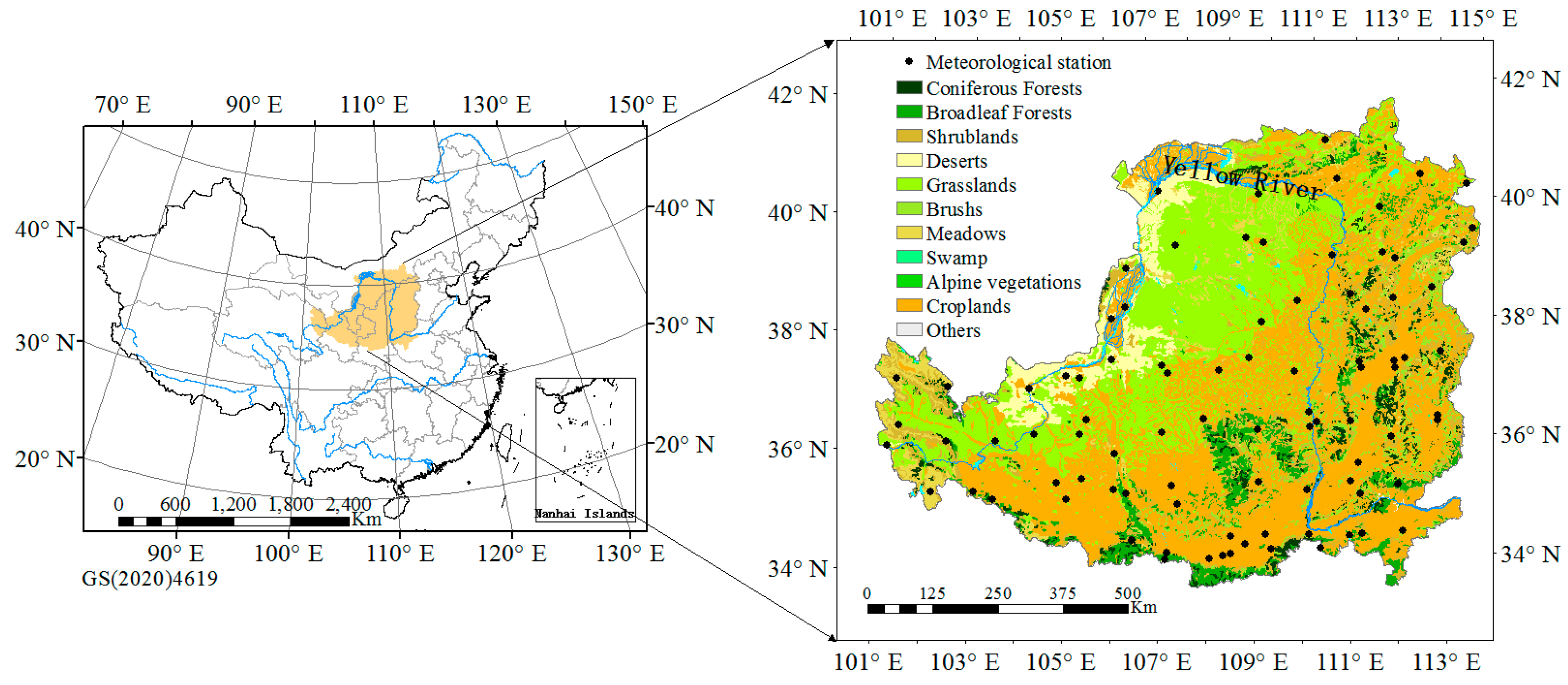
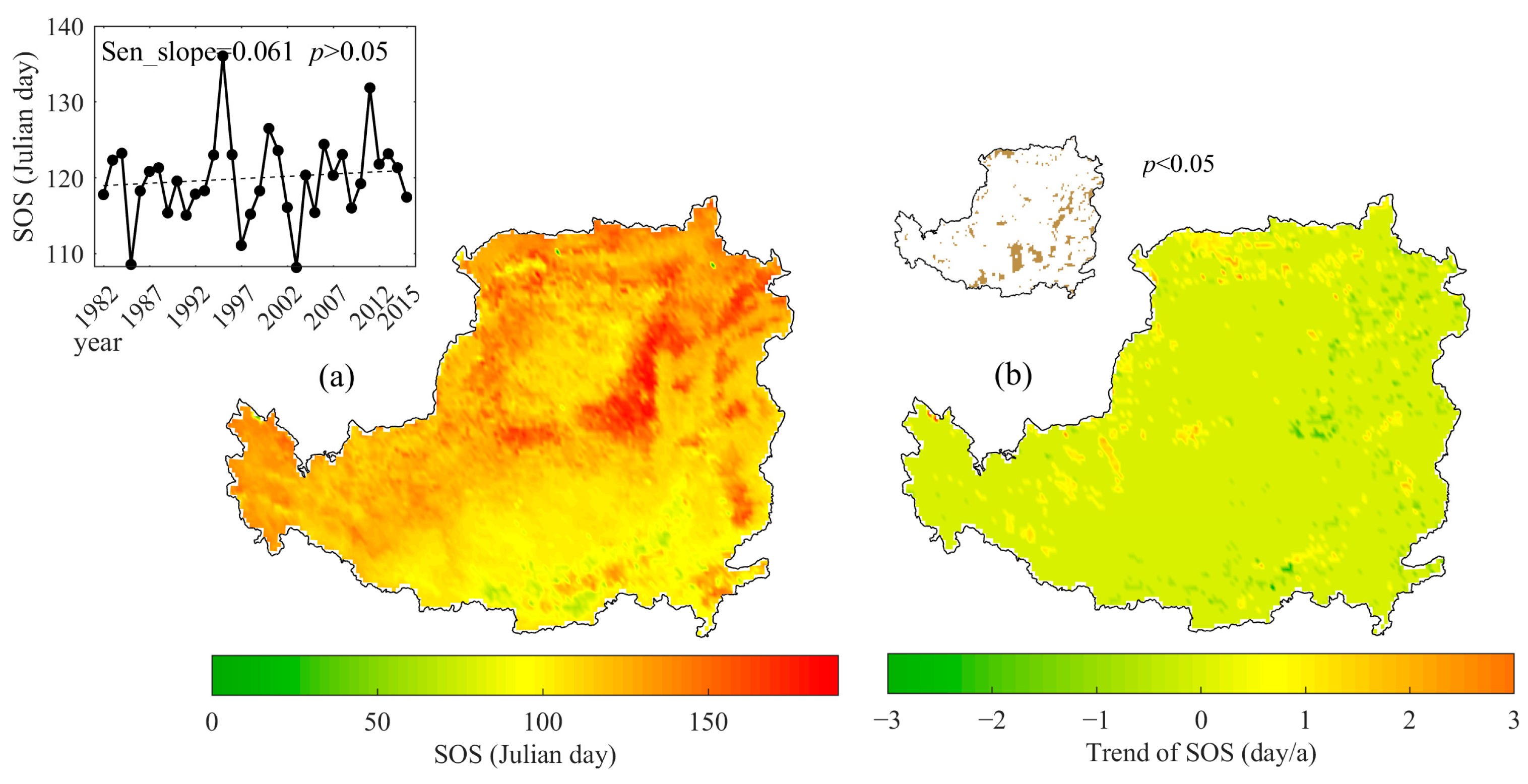
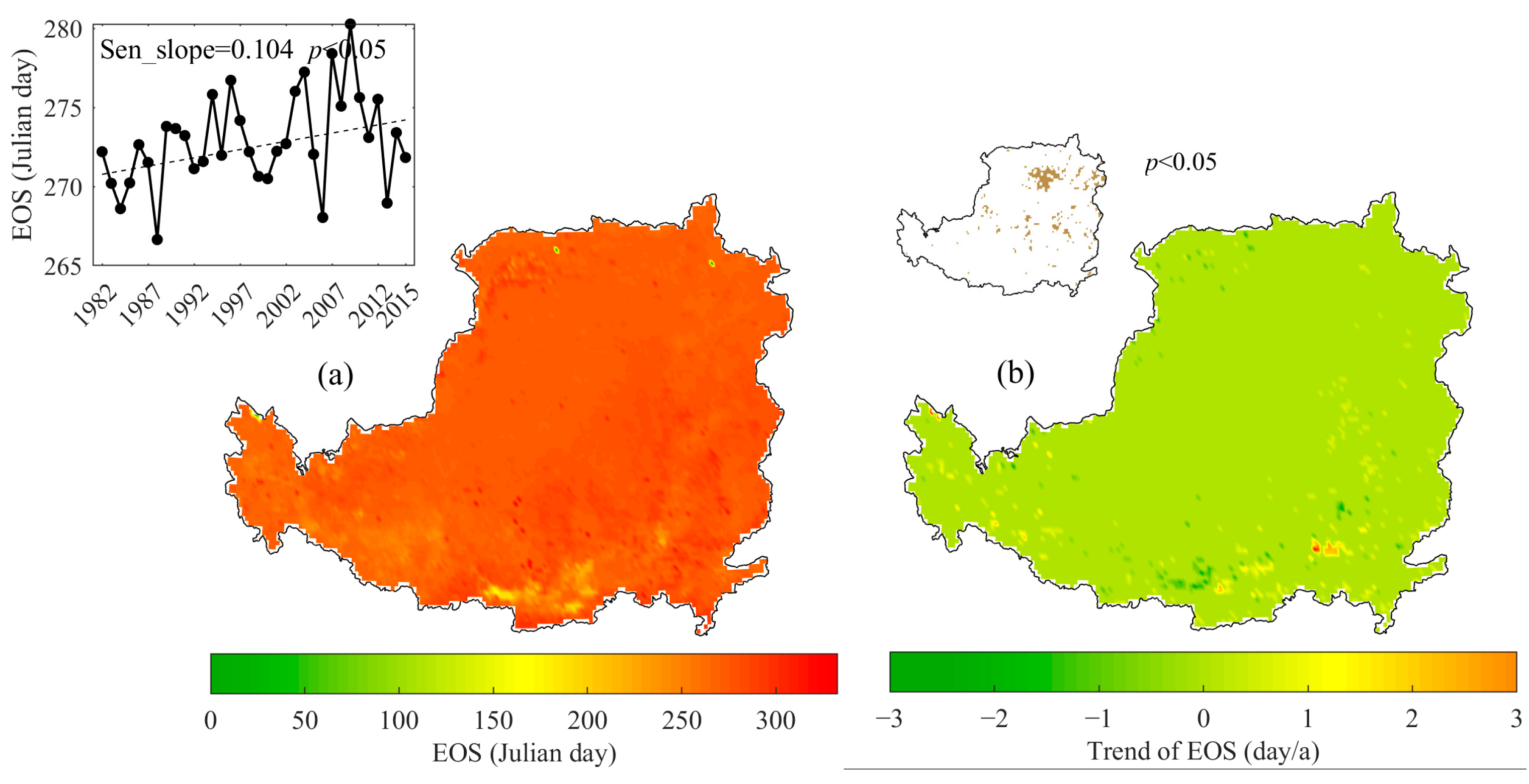




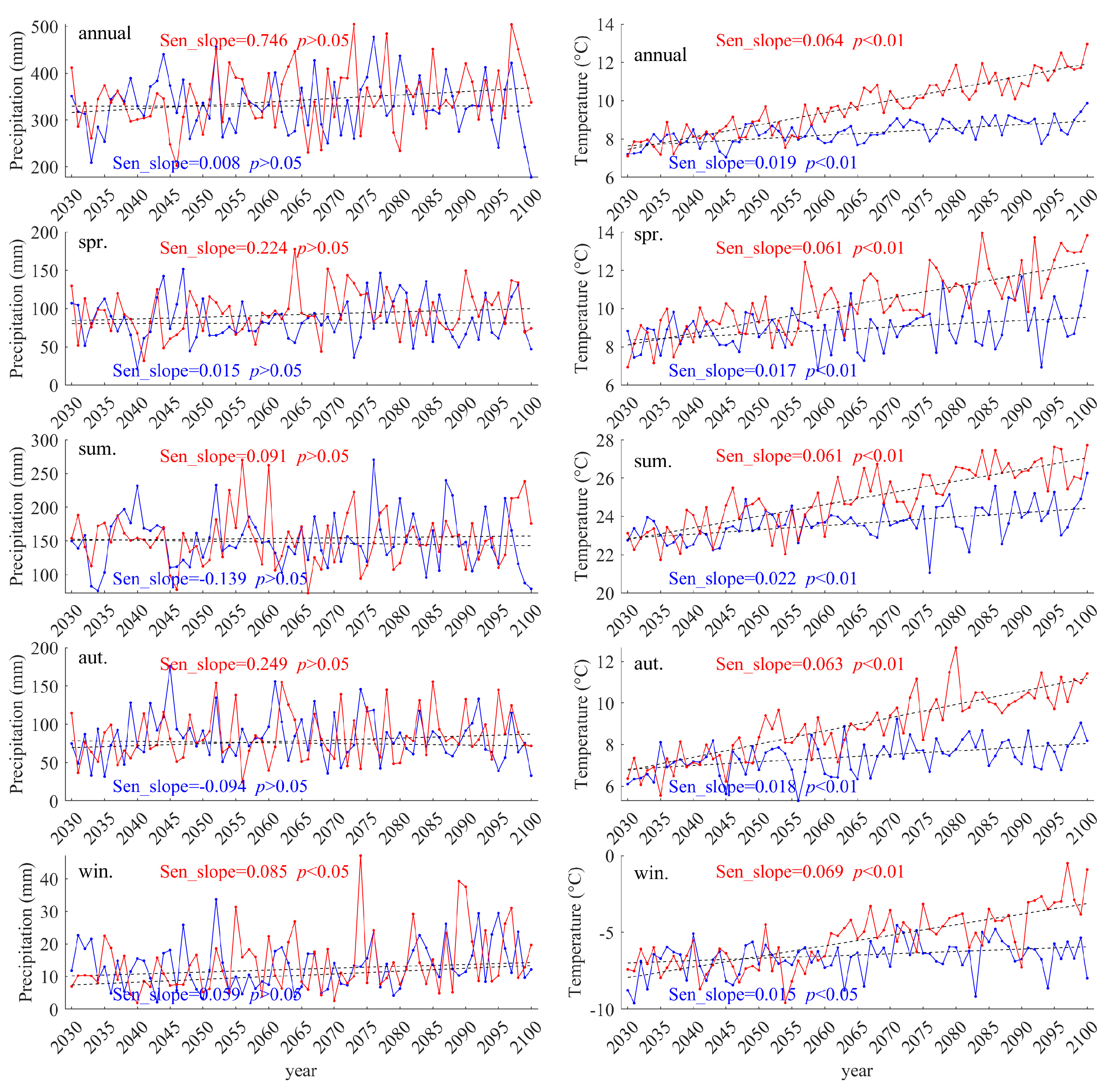
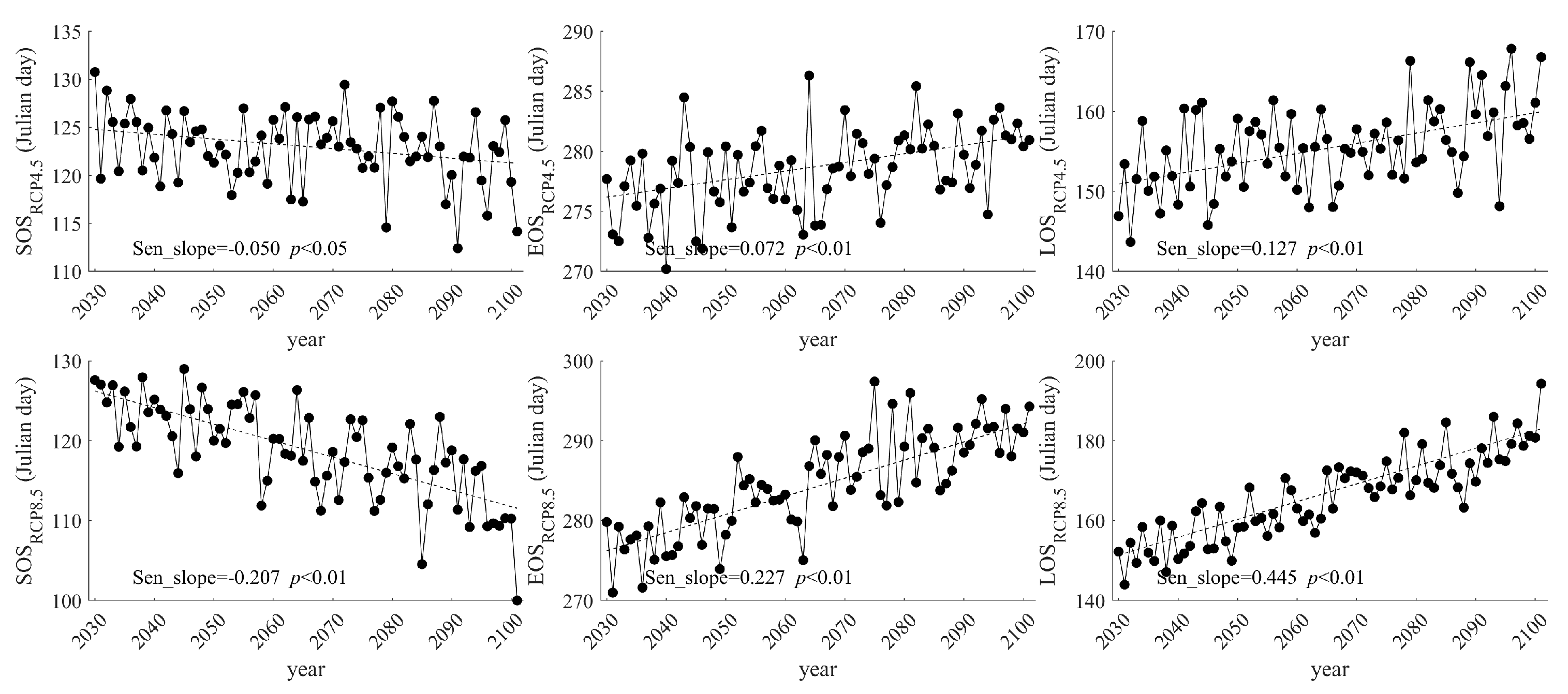

Disclaimer/Publisher’s Note: The statements, opinions and data contained in all publications are solely those of the individual author(s) and contributor(s) and not of MDPI and/or the editor(s). MDPI and/or the editor(s) disclaim responsibility for any injury to people or property resulting from any ideas, methods, instructions or products referred to in the content. |
© 2024 by the authors. Licensee MDPI, Basel, Switzerland. This article is an open access article distributed under the terms and conditions of the Creative Commons Attribution (CC BY) license (https://creativecommons.org/licenses/by/4.0/).
Share and Cite
Han, H.; Ma, G.; Ta, Z.; Zhao, T.; Li, P.; Li, X. Evolution of Vegetation Growth Season on the Loess Plateau under Future Climate Scenarios. Forests 2024, 15, 1526. https://doi.org/10.3390/f15091526
Han H, Ma G, Ta Z, Zhao T, Li P, Li X. Evolution of Vegetation Growth Season on the Loess Plateau under Future Climate Scenarios. Forests. 2024; 15(9):1526. https://doi.org/10.3390/f15091526
Chicago/Turabian StyleHan, Hongzhu, Gao Ma, Zhijie Ta, Ting Zhao, Peilin Li, and Xiaofeng Li. 2024. "Evolution of Vegetation Growth Season on the Loess Plateau under Future Climate Scenarios" Forests 15, no. 9: 1526. https://doi.org/10.3390/f15091526




